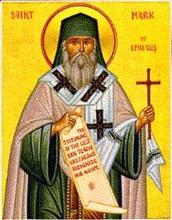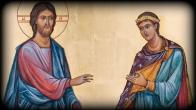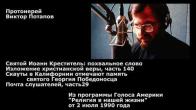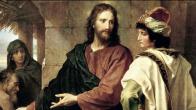You are here
Holy Hierarch Mark Eugenikos, Archbishop of Ephesus
19 January / 1 February
 St. Mark was born ca. 1391-1392 in Constantinople. His parents belonged to a prominent family of considerable means. His father was a deacon at the Church of the Holy Sophia, the Wisdom of God. His mother was the daughter of a physician. In Holy Baptism, the future Holy Hierarch received the name Manuil (Emmanuel, meaning “God is With Us”); one can see in that fact a prophetic description of his future significance to the Church.
St. Mark was born ca. 1391-1392 in Constantinople. His parents belonged to a prominent family of considerable means. His father was a deacon at the Church of the Holy Sophia, the Wisdom of God. His mother was the daughter of a physician. In Holy Baptism, the future Holy Hierarch received the name Manuil (Emmanuel, meaning “God is With Us”); one can see in that fact a prophetic description of his future significance to the Church.
Manuil’s first instructor in academic subjects and in piety was his father. The boy was so successful in his studies that while he was still a young boy, his father schooled him in rhetoric and mathematics. When he was 13, Manuil lost his father, but did not succumb to laziness; he continued his studies in Constantinople with renowned professors John Cartasmeno and George Gemistus Plethon. Thanks to his great dedication, remarkable intellect and unquestionably high morals, soon the future confessor of the Church himself became an instructor, attracting the most talented youth. His great spiritual gifts would not remain unnoticed. Manuil became the favorite spiritual child of Patriarch Euphemius of Constantinople (1410-1416); the future Holy Hierarch’s closeness to and love for the Patriarch were later reflected in the canon and sticherae he composed following the archpastor’s death. Emperor Manuil II brought him into his circle as a confidant and advisor. At the direction of Manuil II’s successor, Emperor John VIII, St. Mark authored a great number of compositions addressing difficult theological questions. These works, and the extremely high position St. Mark held among the delegates to the Council in Italy indicated that he was held in great respect by Emperor John VIII.
Thus, closeness to the Emperors opened up to him a path to wealth and to finding all manner of benefits. A brilliant career stretched forth before him. However, the soul of the true lover of wisdom was seeking something else.
In 1418, at the age of 26, Manuil left the capital and went to Antigone, one of the islands then governed by Byzantium , and located at the mouth of the gulf of Nicomedia. Abbot Simeon became the Saint’s spiritual father, and tonsured him into monasticism, with the name Mark. That great spiritual director, about whom unfortunately more detailed information is unknown, led St. Mark along the narrow path toward salvation.
Life on the island of Antigone was one of constant stress and worry over expected attacks by the Turks. Under such circumstances, it was difficult for the spiritual strugglers to maintain calm, focus, and silence. Thus, Mark and his spiritual father departed for a new home at the famous Monastery [of St. George] of Mangana in Constantinople . There the spiritual Elder reposed, and there Holy Hierarch Mark later valiantly completed his own life’s course. At the Monastery of Mangana, the Saint gave himself over to the greatest spiritual struggles.
At the Emperor’s direction, St. Mark was appointed Metropolitan of Ephesus after the aged Metropolitan Joasaph reposed in 1437. The Holy Hierarch was not to remain long with that flock. On November 24, 1437, he left for Italy as part of an enormous delegation to the Council of Ferrara-Florence.
The bulk of the Greeks who left for Italy went with a sense of spiritual enthusiasm. Before their departure, patriarch Joasaph had said that they were going to the Council to contract a Union, but that they would not compromise any of the traditions of the Holy Church that had passed on to them, and that if need be, they were ready to die for those traditions, for what could be more glorious than a martyr’s crown?! Alas, everything turned out otherwise. As we know, the Patriarch never returned to Constantinople, but died in Florence. Orthodoxy was betrayed and sold out, and the Greeks returned to their Homeland not as conquerors bearing spiritual trophies, but in shame and sorrow.
The Council, held to consider the question of unification of the Eastern and Western Churches, was solemnly convened in the Cathedral Church of Ferrara on April 9, 1438. Emperor John VIII Palaeologus, head of the delegation, looked upon the Unia as a political act allowing Byzantium to count on Western support in its battle with the Turks. The Emperor, in whose court Italian influence was great as the result of his marriage to Sophia of Monferrato, thought that reaching an agreement with the West was not merely possible, but essential. Accordingly, he summoned to his ranks such accomplished enthusiastic supporters of Orthodoxy as Holy Hierarch Mark, and demanded that at the Council, sharp polemics with the Latins on theological questions be avoided. He hoped that a compromise acceptable to all might be accomplished through vague wording. Pope Eugene IV of Rome pursued other goals. First of all, he wanted to use the Unia to raise his prestige in the Catholic world, something that had been shaken at the Council of Basle; second, he wanted to assert his control over the Orthodox Church. Therefore, he insisted that as soon as possible, the two Churches form a bilateral commission to identify and analyze the points of contention between the two sides, and to chart the paths to contracting a Unia. After some delay, the Greeks authorized only Holy Hierarch Mark of Ephesus and Metropolitan Bessarion of Nicaea to take part in discussions with the Latins. Of those two, St. Mark took the lead, and was also authorized to represent the Patriarchates of Alexandria and Antioch.
At the request of Cardinal Julian Cesarini, before the commission began its work, St. Mark laid out for Pope Eugene IV the position of the Greek delegation. The Holy Hierarch yearned for Church unity, believed that a Unia was possible, and sought unity with the Latins, but a true unity, based on unity of faith and ancient liturgical practice. Holy Hierarch Mark emphasized that the purity of Orthodoxy must be preserved, and that the talks might end without success unless Rome made certain concessions, renouncing innovations introduced into the dogmas and liturgical practice of the Western Church which were alien to the ancient Church and which were reasons for the schism. The Cardinal immediately delivered that appeal not only to the Pope, but to Emperor John as well. The Emperor, who had naively hoped that in concluding the Unia, painful theological questions could be avoided, was extremely displeased, and even wanted to have the Holy Hierarch brought to trial before the Synod. However, at the urging of Bessarion of Nicaea and others, he did not act on that proposed decision. At the same time, the Pope demanded ever more insistently that the Greeks explain themselves, and finally, at the third session of the commission the Catholics themselves proposed issues for consideration: 1) the issue of the Procession of the Holy Spirit; 2) the issue of the use of azymes, unleavened bread, for the Eucharist in the Roman Catholic Church; 3) the teachings with respect to Purgatory; and 4) the primacy of the Pope of Rome.
The Greeks considered the question of Purgatory to be the simplest one, and that coming closer together on that issue would more likely allow them to come closer to agreement on the other issues. However, the subsequent debate on that question, during which Holy Hierarch St. Mark of Ephesus spoke out several times, ended without result on July 17, 1438. The Greek delegation did not agree to accept as dogma the Latin teaching with respect to a purgatory fire through which sinners could avoid eternal torment by undergoing a temporary punishment and purging. Such a view would cast doubt on the Church teaching with respect to an after-death recompense, and would tempt people of weak faith to take a “broad path” to salvation.
After the Orthodox and Latins failed to reach agreement with respect to Purgatory, the first question under discussion, and after the first attempt to find rapprochement on Orthodox and Catholic dogmatic positions failed, followed several months of inaction. It was only on October 8, 1438 that new discussions were begun, on the most important point of disagreement between the two sides – the question of the “Filioque” (i.e. “and [from] the Son,” the Roman Catholic teaching that the Holy Spirit proceeds not only from God the Father but also from God the Son.) The Latins insisted that the actual teaching with respect to the “Filioque” be reviewed, but the majority of Greeks, together with St. Mark of Ephesus, demanded that they review the question of whether it was legal to make any alteration in the Creed, the Symbol of Faith. In the course of discussions, St. Mark cited the decision of the Third Ecumenical Council which directly forbade such alterations, and called upon the Latins to acknowledge their error. However, Roman Catholic orators, aware of how vulnerable was their position, strove to justify themselves through a variety of subterfuges. After many sessions in which a number of orators spoke, many of the Greeks came to the conclusion that discussions with the Latins were going nowhere, and that it would be better for them to return to Constantinople.
In early January 1439, at the last meeting of the Council in Ferrara, a papal bull was read, announcing that the Council was being moved to Florence. Florence became the place at which, in St. Mark’s words, the Latins threw off their masks, not just with respect to their attitude toward the Orthodox delegates, but with respect to their treatment of them. The Orthodox Greeks found themselves in a difficult position: exhausted, suffering from privations, submitted to a variety of restrictions, lacking the resources to return to their homeland, and recognizing Byzantium’s truly sorry state. In effect, they were invited to “sell out” the Orthodox Church in return for generous assistance both to the state and to the Greek delegates to the Council; they were even promised that a Crusade would be launched against the Turks. All of these factors led to a fracturing of the unity that had made the Greek delegation so strong in Ferrara. While in Ferrara, Holy Hierarch St. Mark of Ephesus had had the support of Metropolitan Bessarion of Nicaea and Isidore of Kiev, and the Emperor himself was on the side of the enthusiastic supporters of Orthodoxy, but in Florence the picture changed. The Greek hierarchs’ original objectives – to preserve Orthodoxy in all of its purity and to sway the Latins toward Unia by convincing them that they had an erroneous understanding of the dogmas on which they disagreed with the Orthodox – were replaced by a search for compromising, ambiguous decisions and unstable, shaky, dogmatic definitions. The fundamental theological search pursued by the Greek delegates became “To find some middle ground.” In essence, Holy Hierarch St. Mark of Ephesus found himself alone, in isolation. The Catholics, in their turn, no longer sought an agreement on unification, but rather sought unconditional dogmatic and administrative capitulation by the Eastern Church. Having accepted the Latin “Filioque” teaching, the Orthodox delegates to the Council of Florence were forced to compromise on other issues as well. On July 5, 1439, they signed the Florence Unia. St. Mark was the only Council participant who did not sign the Act of Union. In fact, he turned out to be the only one to have defended Orthodoxy. That is evidenced by the fact that on hearing of St. Mark of Ephesus’ categorical refusal to sign the Acts of the Council, the Roman Pope stated that the Unia was a complete failure.
St. Mark, along with the Emperor and others who represented the Orthodox Church at the Council in Italy, returned to Constantinople on February 1, 1440. An active opponent of the Unia, St. Mark left the capital on May 15 without notifying the Emperor. He departed for Ephesus, which was under the control of the Turks. There St. Mark devoted all of his efforts to putting his ravaged diocese in order: converting those who had gone astray, ordaining priests, and interceding with the authorities on behalf of the needy. At the same time, he considered the battle against the Unia to be the most pressing issue. Thus, in his encyclicals, he continued to denounce the Greek-Catholics and the decisions of the Council of Florence. An encyclical he addressed to all Orthodox Christians of the East in July 1440 was of particular significance. It elicited both extreme dissatisfaction on the part of the uniates, and wrath on the part of the Emperor. As a result, during a journey to Mt. Athos, the Saint was arrested on the island of Limnos, and was incarcerated for two years, during which he suffered from sickness, a severe climate, and deprivation of many of the essentials of life.
In 1442, at the order of the Emperor, Holy Hierarch St. Mark was released, on the day of commemoration of the Holy Seven Youths of Ephesus (4 August or 22 October). In a poem written on that occasion, the Archpastor thanked the Holy Youths of Ephesus for their intercession and assistance. St. Mark returned to Constantinople , where he lived until his blessed repose in 1457. It was God’s Providence that he remain a warrior for Orthodoxy until his final hour.
PARISH LIFE
RECENT VIDEOS
Address of our Cathedral
Subscribe to our mailing list
While all the materials on this site are copyrighted, you may use them freely as long as you treat them
with respect and provide attribution on the Russian Orthodox Cathedral of St.John the Baptist of Washington DC.









